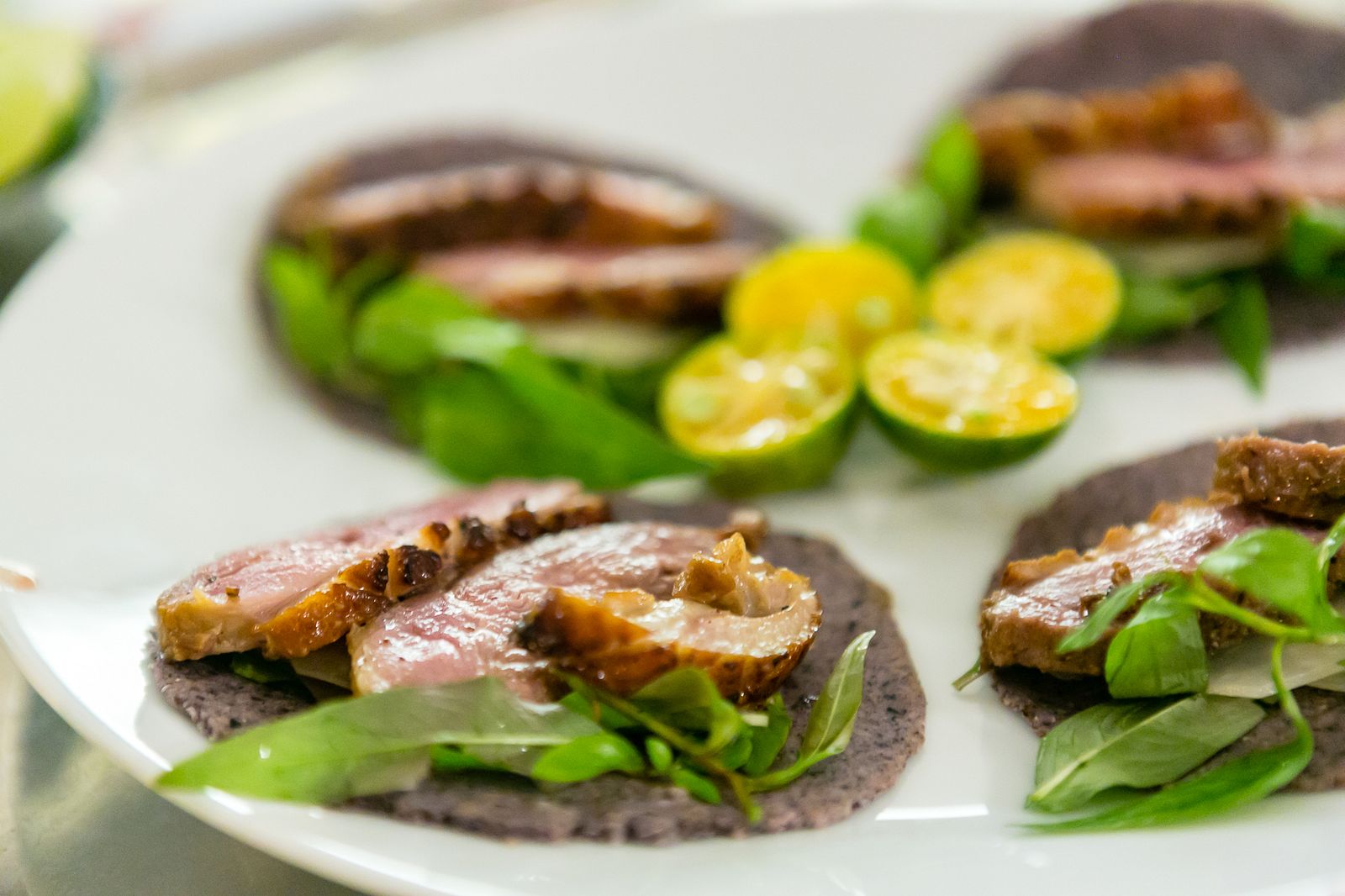Fight or flight: to ball fists, rally rag-tag villagers clutching canes, shovels, sampan oars and bamboo staffs to ward off the bayonet-wielding officers invading your home intending to ransack your cabinets and storerooms, aiming to whisk you off to prison based on the scantest of evidence; or, to scoop up your ceramic pot of illegal alcohol, slip out the back door and flee far into the rice fields, where you hide for hours until the rising moon signals a safe passage home, hunched deep in the cold muck, shaded by growing stalks and comforted by cricket song.
To understand this choice that hundreds of Vietnamese once faced, we must go back several centuries. While Vietnamese and their ancestors have been consuming alcohol for thousands of years, removing water from the liquid to increase its potency — a process known as distillation — dates back only to the 14th century in Asia. Since then, rice wine has been an integral part of Vietnam’s social traditions, economy and culture. Examining its history not only provides insights into rapidly disappearing ways of life, but also French colonialism’s far-reaching and disastrous impact on the country.
Defining Rice Wine
To make rice wine, one simply rinses freshly harvested rice, boils and cools the grains and then, along with water and a starter, stores it in ceramic pots to allow for natural fermentation. After several days or weeks depending on the weather and climate, the alcohol is then distilled using a crude system involving a pot, condenser and receptacle. The resultant liquid can be consumed immediately, distilled again to remove more impurities or infused with various fruits, vegetables and herbs for a more complex flavor with purported medicinal value.

Traditional still system. Photo via Kookbang.
In Vietnamese, rice wine and other alcohols, in general, are referred to as rượu, but the name gets more specific depending on the region, type of rice used and additives. Rượu gạo in the north and rượu đế in the south refer to plain distilled rice wine made with either glutinous or non-glutinous rice. Various fruits including plum, apple, apricot, pomelo and sapodilla are often added to the liquid which is then sealed for up to several years to intensify the flavors.
The cost of the labor, storage time and added ingredients, however, means the majority of rice wine typically consumed is unadulterated and called rươụ trắng (white wine). Rượu thuốc (herbal wine) refers to rice wine that has been infused with medicinal herbs, plants or animals including snake, lizard, bird, monkey, pangolin and tiger parts and is purported to cure a wide range of physical ailments and improve, to no one's surprise, “men’s virility.” Rượu cần is a variety commonly found among ethnic minorities in the central highlands made with purple sticky rice, honey, lemongrass and is consumed communally from ceramic jugs using large straws.

Drinking rượu cần. Photo via Bao Dan Toc.
The solid starter, known as men in Vietnamese, is a key additive and the reason that a neglected pot of rice won’t magically turn into wine. The specific ingredients differ by region and distiller but the mixture always includes mycelial fungi, yeasts and bacteria. The fungi convert the rice into soluble sugars that the yeast ferments into alcohol. The starters help determine the quality, yield and taste of the rice wine; thus, people closely guard their recipes, which often include a panoply of herbs, spices and supplements such as garlic, pepper, onion, rhizomes and Chinese medicinal herbs.
In 1892, Albert Calmette, a man whose importance to this story will soon become apparent, made a list of 42 different ferment ingredients he identified in his laboratory which included clove, tamarind, anise and bitter orange. While mostly chosen for their aromatic qualities, some of the additives may contain antibacterial properties that safeguard the wine during production while others are considered to have important health benefits.
As everyone who has consumed rice wine knows, its English translation is a complete misnomer as it's not a wine at all, but a liquor. Moreover, unlike Western wine, which is typically 12-16% alcohol by volume (ABV), distilled rice wine can range anywhere from 20% to 50% ABV, making it more akin to hard alcohol.
Historic Role of Rice Wine in Vietnamese Culture
As a staple product in Vietnamese villages for centuries, rice wine had both practical and ceremonial values. When the nation consisted mostly of rural villages and small towns, men — and to a lesser extent, women — consumed it before going into the fields, at lunch, and with dinner. It was also seen as an important part of a healthy lifestyle and a way to both ward off and cure illnesses, as attested to by the phrase “bán dạ tam bôi tửu [...] lương y bất đáo gia" which translates roughly to “three cups of liquor at midnight keeps the doctor away.”
Rice wine also held a significant position in many traditional activities. Expensive varieties aged with fruit were often saved for special occasions including lunar new year, death anniversaries and weddings. Moreover, during engagement ceremonies, historically the groom was required to provide the bride’s family with eight to ten jars of rice wine while on the wedding day the families shared a ceremonial cup together.
Whether enjoyed during a festival or on a casual afternoon, rice wine itself was consumed with little flair. No parallels can be made to Japan’s elaborate tea ceremonies or the dogmas surrounding communion wine. Instead, this drink enjoyed by people of all classes was consumed unpretentiously from hollow gourds or earthenware. The lone rituals included everyone typically sharing a single glass, serving elders first and when houses were constructed with simple dirt floors, the first pour would be splashed onto the ground as an offering to ancestors and in appreciation for the earth’s generosities.

Photo by Paul Christiansen.
Rice wine played a significant role in household economies. For much of the nation’s history, it was produced in very small batches for individual family use or to share and sell within small communities. The relative ease and flexibility with which it could be produced often meant women would manage its production while fulfilling domestic and child-rearing duties. Producing rice wine was part the of interconnected operations of most agrarian households. Families would use some of their rice harvests to make the wine and give the grains left over after fermentation to their pigs. In this arrangement, their priorities were feeding the pigs which were more lucrative and the rice wine was a welcome byproduct.
During the 19th century, as Vietnam became slightly more urbanized with increasingly complex mercantile systems, the nation’s rice wine industry underwent moderate changes. Specialization emerged between cooperating families or villages such that one might work to provide rice, another pottery and a third busy itself with fermentation efforts. In the south, small factories were established, the largest of which could produce 600 liters of liquor per day.
During this pre-colonial period, ethnic Chinese had a disproportionately prominent role in commercial activities throughout Vietnam. Nowhere was this more evident than in rice wine. As the country moved beyond single homes making all their own rice wine and toward profit-producing small factories and trade networks, the Chinese increasingly controlled its production and distribution. The Vietnamese government, learning from the Dutch, took advantage by collecting taxes on the production as an important way to supplement direct taxation schemes. These “tax farms” served as an important model and entry point for the French colonial regime that would use rice wine as a means to control the native populace in a misguided and bloody attempt to extract money from the region.
France’s Arrival on the Alcohol Scene
In the second half of the 18th century, France widened its imperial ambitions in Indochina, establishing a formal colony. While attempting to exert greater control in its territories, lawmakers in Paris were increasing their demands that all colonies be not only self-sufficient but profitable. It is within this context that the colonial government looked to alcohol, in addition to salt and opium, to extract money or at least establish the appearance of profit against which to borrow money.
Historian Gerard Sasges details what follows in extreme detail in his book Imperial Intoxication: Alcohol and the Making of Colonial Indochina and several articles including "State, Enterprise and the Alcohol Monopoly in Colonial Vietnam." The following summary borrows heavily from his work as well as Taste, Taxes, and Technologies: Industrializing Rice Alcohol in Northern Vietnam, 1902-1913 by Erica J. Peters, while unfortunately excluding many interesting details, developments and characters, and making some simplifications.
France’s meddling in the Vietnamese liquor market began with simple taxes on imported alcohol in 1862 and money collected from the existent Chinese-operated tax-farms. Gradually, however, they consolidated control on the market first through a licensing system that outpriced small, native distillers and then, through regulations requiring expensive brick, masonry and tile facilities that were well beyond the reach of individuals. By the end of the 19th century, the colonial government had replaced the Chinese producers with private French entrepreneurs and established, on paper at least, a complete monopoly on the production, distribution and sale of rice wine.
Not Your Grandfather’s Rice Wine
As is to be expected of a monopoly, once the government had control of the market, it increased prices four-fold in 1897. But perhaps even more offensively, the very rice wine they were selling hardly resembled the alcohol that Vietnamese had been consuming for hundreds of years. Instead of subtle flavors reflecting a vast array of fruits and herbs carefully steeped, mixed and selected according to secret recipes and time-honored family traditions, everything the state produced and sold was industrial, aggressive and one-dimensional. The nearly pure ethanol poured at almost 45% ABV and was devoid of any of the soul that seeps in from heirloom pots and the rice-shucking hands of loved ones.
The reason for the unappealing product can be traced back to Albert Calmette, a scientist and doctor whose name is immortalized on a Saigon street today. Following in the footsteps of Louis Pasteur, Calmette researched vaccines including one for rabies while briefly stationed in Vietnam. The colonial government, however, saw no economic value in his tinkering with medicines and pressured him into researching alcohol and opium production. Inspired by recent Western breakthroughs in isolating the fermentation microbes in beer and wine, Calmette successfully identified the specific microbe in the Vietnamese starter that led to saccharification and fermentation.

Albert Calmette. Photo via Anton Mansch.
By isolating the active organism required for rice wine production, Calmette was able to optimize the process, halving production time while doubling output. With an eye on profits, the colonial government supported a young French entrepreneur named A.R. Fontaine in creating a humongous factory that relied on Calmette’s science. His 45,000-square-meter structure in Hanoi could operate around the clock, processing 100 tons of rice paddy and 20,000 liters of pure alcohol a day.
By eschewing traditional wood and ceramic stills for huge, state-of-the-art metal column stills, Fontaine could churn out rice wine far more efficiently. However, the new method’s precision removed many of the imperfect elements that contributed to the taste and aroma of traditional rice wine. Because of the sheer volume and concern with bottom-line costs, Fontaine relied on much lower quality rice and occasionally added corn or other fillers. Sometimes unclean water was added to reduce the alcohol content at the point of sale while the factory’s metal pipes occasionally spilled poisons into the liquid. Moreover, his product was also much stronger than homemade wine, leading to extreme drunkenness and hangovers.



Images from an industrial French distillery in Hai Duong Province in northern Vietnam. Photos via L'Agence Photos.
Vietnamese widely and vehemently detested the state liquor. That mattered little to the French who lacked an appreciation for the nuances of rice wine, considering it altogether inferior to their own alcohols. And even if they did understand that they were producing a vastly inferior drink, their monopoly afforded them the option not to do anything about it. Further, during this time in history, anything produced via modern science and industrialization was considered inherently superior to older methods; a notion exacerbated by racist concepts of colonial pacification and civilization.
The massive factories employed by the French operated outside of holistic home economies which caused new problems. By moving all production to a single location, the spent grains that once fed family pigs became a massive trash collection problem and the previously valuable resources were simply dumped at the expense of local environments. Further, without cheap feed for their animals, once-lucrative family pig farms disappeared, drastically increasing the local price of pork while robbing peasants of a stable income source.
Bloodshed, Dissent and Corruption
For the liquor monopoly to work, the colonial regime had to crack down on illegal distilling operations through draconian penalties. Individuals found guilty of producing contraband rice wine were subject to fines of between 25 and 1,000 piastres. To put that figure in perspective, at that time a distillery master’s monthly salary in Cochinchina was 10 piastres while laborers earned 0.75 piastres each. Offenders could also face up to three years in prison.
Making matters worse, the burden of proof was exceedingly low and simply having distillation utensils or rice, tubers, and fruit in the process of saccharification or fermentation were seen as proof of illegal alcohol production. Moreover possessing any amount of contraband rice wine was treated the same as if one were producing it. Ultimately, thousands of Vietnamese were arrested and put in prison for alcohol-related crimes, meaning the majority of people incarcerated during the colonial period were held for rice wine-related charges.
To support such extensive enforcement, the government had to establish a massive Department of Customs and Monopolies. It required twice the resources as the next largest department — the civil service responsible for the colony’s day-to-day administration. France spent money so disproportionately on protecting their alcohol monopoly that the average Vietnamese was five times as likely to interact with a customs official as they were a government employee involved with education. Such a reality established an understandably resentful view of the French administration as a whole among the native population. People that might otherwise be indifferent towards the colonial government were quickly radicalized because of the alcohol laws.
The resentment over the quality of sanctioned alcohol and punishment for contraband manifested into major and minor violence against colonial officials. Countless anecdotes litter the historical records of assaults, beatings and even murder resulting from standoffs between customs officials and suspected alcohol counterfeiters with women and children occasionally on the receiving end. The French and native officers who performed household and village searches relied on brutality or the threat of such to enact the unpopular laws in areas where they were greatly outnumbered.

Photo via Political Theology.
In addition to terrorizing citizens to curtail the bootlegging of alcohol, the government initiated several laws aimed at making the unpalatable factory version unavoidable. Per-village quotas were set for consumption and households were required to purchase a certain amount during festivals, ceremonies and animal-slaughtering rituals under the logic that these events always involved ritual drinking and, were the Vietnamese not buying state liquor at the time, they were certainly securing counterfeit varieties.
Despite the significant financial expenditures and commitment to enforcement, efforts to combat illegal rice wine was wholly ineffective. Some estimates claim that 60% of Vietnamese purchased contraband alcohol. Subversion and smuggling, frequently performed by women, help explain such a high figure. Relying on hidden compartments in baskets of market-bound vegetables, empty gas cans, and clandestine wineskins strapped to their stomachs, women were integral in transporting the alcohol from rural factories to urban centers.
More than the work of sneaky hooch sellers, it was widespread corruption motivated by bottom-line profits that prevented the government from effectively stamping out illegal alcohol. Underpaid officials were quick to take bribes and look the other way while distillers took advantage of familial connections and long-established relationships with the Vietnamese who joined the colonial enforcement efforts. The laws were so widely scoffed at that one of the most common places to find large, illegal still operations was on concessions — lands the government gave to French officers and administrators to spur economic growth. Working with near impunity, they pumped out enough illegal rice wine to sometimes supply an entire province.
By the early 1920s, it was clear that France’s efforts to fund its colonial ambitions through a monopoly on rice wine was a complete failure. Realistic projections placed the government’s hold on the market as between 30 and 50% at its height. Due in large part to mismanagement and responses to the product, Fontaine's company was completely bankrupt. Regardless of how large, violent and well-funded a customs department the colonial government could establish, there was simply no way to coerce Vietnamese from abandoning their traditional rice wine thanks to the importance of small-batch distillations’ effects on taste and home economics, as well as its role in both ceremonial and daily life.

Painting by Tuan Dinh via Upsidedownism.
This is the end of part 1 of our series on the history of rice wine production and consumption in Vietnam. While the monopoly proved unsuccessful, revising laws and regulations still required significant work, uncertainty and room for abuse. Part 2 examines how the rice wine landscape evolved past a state-monopoly and what effects its legacy has had on modern-day consumption, production and perception. Read Part 2 of the series here.















